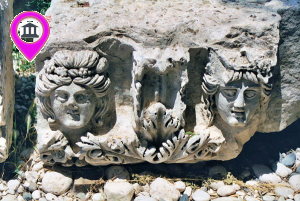* Lycian Way all Etaps
all known ancient Lycian cities

All pre-Greek peoples of Anatolia excelled in building monumental tombs associated with some form of ancestor worship; the Phrygians, Carians and Cilicians had their distinctive styles. The Lycians, however, developed this tradition to its artistic perfection. The landscape of Lycia is thoroughly marked by their strange, evocative and beautiful funerary monuments. Lycian tombs come in three major types. Visually the most striking are no doubt the rock tombs -more or less elaborate funeral chambers carved directly from the rock, usually into a cliff. The oldest of these are simple pigeon-hole cubicles of the sort best viewed in Pinara. More commonly, the graves are fashioned like the facade of a timber house with one, two or three stories -evidently copying the residential architecture of the time. The most elaborate ones are those carved in the form of Ionic temples. The have two columns, a porch and usually elaborate reliefs. Pillar tombs from the second general type of Lycian tombs, the most prominent specimens of which are in Xanthos. These consist of a massive rectangular block of stone, topped by a grave chamber which is surmounted by a "roof". Sarcophagi (sculpted caskets) constitute the third and most common category. Some of these, eg. one in downtown Kas and another in Pinara, are imposing structures; others stand like so many mysterious treasure boxes in the midst of the wilderness -or in the sea, as at the sunken city of Simena (Kekova). Each tomb was originally put under the custody of a committee called mintis which took care of the safety and comfort of the deceased. Tampering with the tombs was subject to cash fines payable to the mintis, the amount being proportional to a premium paid at the time of death. The mintis gone, there was little left to deter grave robbers, and the thousands of Lycian tombs have all been broken into in the course of the intervening centuries. The obsession with buried treasures still haunts these sites: "unathorized diggers", read tomb strippers, ravaged several ancient cities (particularly Cadyanda and Bubon) very recently. Every other person around Elmali seems to possess a metal detector and other gadgets of the digger's trade. Their time does not seem all wasted: in 1984, a splendid cache of 1900 silver coins belonging to the Delian League was discovered near Elmali by some villagers and smuggled out of the country. The world numismatic market was thrown into turmoil when the coins turned up in American auction houses. The greatest robbery of all, however, was perpetrated in the loftier name of scholarship. Lycia was discovered for the modern world by Sir Charles Fellows, the British orientalist, who visited the region in 1838. The beautifully illustrated account of his travels created an instant sensation in London. In 1842 the British Museum agreed to send out a Lycian expedition abroad the HMS Beacon. The research party led by Fellows and Lieutenant Spratt returned to England with 70 huge crates full of archaeological finds, including practically everything that was worth seeing in Xanthos. Did they by so doing save these artworks from neglect and further destruction, or were they little better than treasure robbers themselves? The controversy rages on. Archaeological interest in Lycia in the 20th century has been limited compared to the more famous sites Aegean Turkey. Many Lycian cities remain virtually untouched since Fellows and Spratt's visits. Serious excavations were done only by a French team in the Letoon and a German team in Limyra. In most other places, there are no tourist crowds, not even guards or markers and signs to disturb the peace of the ruins. What may be lying under the ground is hinted by the case of formerly obscure Arycanda: here, the work of Turkish archeologist Cevdet Bayburtluoglu has begun to reveal what may turn out to be one of the most spectacular ruin sites in all Turkey.
 * Ancient Cities on the Map / MAP & LIST
* Ancient Cities on the Map / MAP & LIST
 * Lycian way accommodations on the Map / MAP & LIST
* Lycian way accommodations on the Map / MAP & LIST
* Lycian Way all Etaps
* Lycian Way all Etaps

